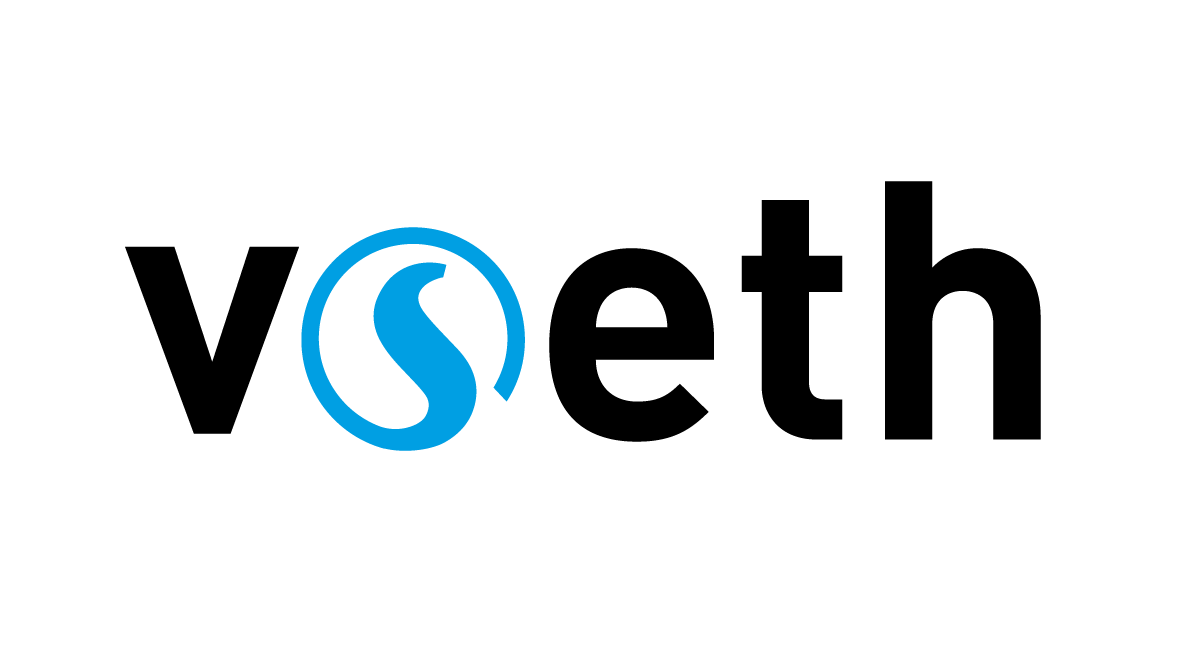SSC Blog
In this page, you can find various articles written by our members. Some are opinion pieces, some are works of fiction. Enjoy!
I attended the Swiss Impact Forum as a student and a member of the Student Sustainability
Comission (SSC) looking for sustainable companies. Why? Over 70 percent of students say to seek
a career that benefits them, the society and the environment. But which companies truly satisfy
these conditions? What does it even mean to be a sustainable company and how do we become one?
Are the people working there happy? And could the business world’s strategies inspire sustainable
policies within universities ? These questions found their answers at the Swiss impact Forum.
The event is designed for companies who either already are sustainable (for instance those holding
the B-Corp certification from B Lab) or for those who are looking for concrete steps towards
sustainability. There were also some students, making thus a nice connection between prospective
employees and companies committed to sustainability.
One of the things I liked the most was the diversity of attendees. A start-up entrepreneur seeking
advice on making their business socially and ecologically responsible. Representatives of NGOs,
multinational corporations, small Swiss companies, fresh graduates and experienced professionals.
This diversity really generated energy and sparked many interesting conversations during breaks.
However, this day was not only about networking and exchanging on sustainable strategies. It was
also an opportunity to learn how and with what concrete steps to encourage a paradigm shift within
the business world. The day actually started with a very moving performance from a Swiss poet
Franz Hohler of a 50 year-old poem about the world’s end due to climate change. A great reminder
of the urgency to act and a great motivation to spend the day looking for solutions.
Various conferences and workshops took place to enlarge our knowledge. Wanting sustainability is
easy, achieving it is far more challenging. These workshops were designed to help companies to
take the correct steps towards sustainability. The offer of events was enormous, choosing the ones to
attend was a difficult task. After the opening panel, it was time for workshops. I opted for corporate
activism. It was about companies who have or who want to have the courage to speak up and
commit to a greener and fairer world. Conversations with employees of such companies revealed
workplace passion and the advantages of working there.
Later in the day, I also participated in a workshop on the B-Corp certification, understanding how
we can evaluate a company on sustainability.
Amongst others, food for the future or the role of the policies were also discussed during panels.
The bilingual nature of most panels and workshops provided a uniquely Swiss experience : a mix of
French and German was resonating through the venue.
All this was complemented with an outstanding catering – obviously vegan and local – reflecting
thus B Lab’s commitment to sustainability.
As I settled into the train journey home, happy but tired after a socially and intellectually active day,
I felt a glimmer of hope. Witnessing companies dedicated to change left me with a sense of
optimism. I wish for more events like the Swiss Impact Forum and for more associations such as B
Lab in order to inspire even more companies to join the sustainable movement. It’s through such
collective endeavours that a brighter, more sustainable future becomes increasingly attainable.
Long-story short: I stumbled upon a breath-taking exhibit on wildlife photography!
As part of my inter-rail Scandinavian trip, I was heading to Copenhagen’s highly acclaimed botanical garden but, although they’re very nice, they’re not what I want to tell you about today. Rather, the Natural History museum was hosting an exhibit on wildlife photography. I love animals, and my brother is somewhat of an amateur wildlife photographer, so I said “why not!” and bought a ticket.
I half expected some photographs to be more or less related to the climate crisis and human actions’ consequences on wildlife because, well, we’re fucking it up big time. But the extent to which the exhibit was making links between each photograph and our impact on the environment was just breathtaking.
Here are my favorite shots. Let’s start with the kind of depressing ones:
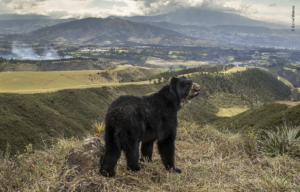
Spectacled bear’s slim outlook, Daniel Mideros
At the heart of the image, perfectly framed, a spectacled bear gazes down upon the deforested hillsides, farming terraces and the city’s urban sprawl. Spectacled bears are largely herbivorous and rely on the region’s páramos and cloud forests for food. Found from western Venezuela to Bolivia, these bears have suffered massive declines as the result of habitat loss and fragmentation. Around the world, as humans continue to build and farm, space for wildlife is increasingly squeezed out.
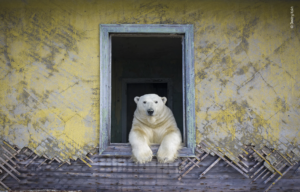
Polar frame, Dmitry Kokh
Polar bears are extremely inquisitive and will often investigate abandoned places in search of food. With climate change reducing sea ice, it is becoming increasingly difficult for polar bears to hunt, pushing them to move closer to human settlements to scavenge.
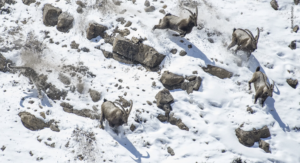
The great cliff chase, Anand Nambiar
Snow leopards live in some of the most extreme habitats in the world. They are now classed as vulnerable and are threatened by climate change, mining and hunting, which targets both them and their prey.
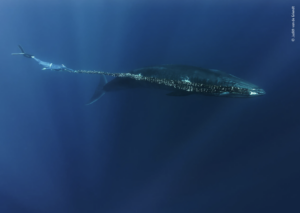
Lethal luggage, Judith van de Griendt
Judith was with a team of freedivers in the Azores when they spotted the Bryde’s whale moving unusually slowly. It was dragging at least 12 metres of discarded fishing net behind it. The team tried to cut it loose but were unsuccessful. Unless the net is removed, eventually it could cause the whale to die a painful death. Most of the abandoned nets found in the Azores are believed to come from boats operating elsewhere in the Atlantic Ocean. An estimated 800,000 to 1.2 million tonnes of ghost fishing gear ends up in our oceans each year, killing millions of marine animals.
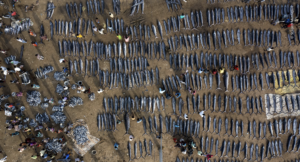
Just one day’s catch, Srikanth Mannepuri
Srikanth was shocked to see so many recently caught marlin and sailfish in one place in a single morning. To demonstrate the scale of the fish market, he used a drone to take the image from a bird’s-eye view. Both sailfish and marlin are top ocean predators and are essential to ecosystems. The local fishermen use traditional longline techniques and sail-power to reach the deep water in the Bay of Bengal where these predators are found. However, the size of the catch is unregulated, and with so many immature fish caught, the industry is unsustainable. Globally, 85% of fish stocks are currently overexploited by humans. Without urgent efforts to protect marine habitats and create truly sustainable fishing practices, we will soon begin to lose species forever.
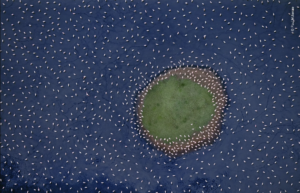
Lake illusion, Paul Mckenzie
The beauty of this picture belies a worrying cause. Unusually high rainfall – a result of climate change – is causing water levels throughout the area to rise sharply. As a result, the mudflats of Lake Solai are now under water, as are the mudflats of a nearby lake where the world’s largest population of flamingos build their nests.
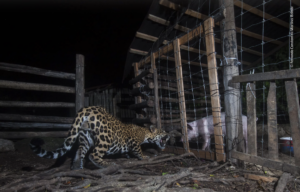
Meeting without eating, Fernando Constantino Martínez Belmar
The jaguar had previously taken a few chickens and a pig from the recreated Mayan village in Río Secreto Nature Reserve. This time workers at the reserve had reinforced the fences not only to protect the pig but to save the jaguar from any retaliation it might receive if it were to take more livestock. Jaguars prefer to prey on large mammals but are known to hunt many species, including birds and reptiles. The loss and fragmentation of their forest habitat increases the likelihood of them coming into conflict with people, especially over livestock. Jaguars are also killed for trophies and the illegal trade in body parts.
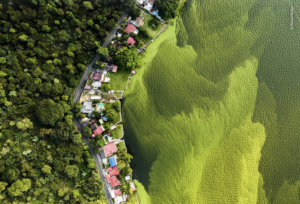
The dying lake, Daniel Núñez
Daniel took this photograph to raise awareness of the impact of contamination on Lake Amatitlán, which receives around 75,000 tonnes of waste from Guatemala City every year. Cyanobacteria flourishes in the presence of pollutants, such as sewage and agricultural fertilisers, forming algal blooms that block out sunlight, killing any plants below. Not only this but they also produce toxins that can poison humans and other animals. When the algal bloom dies, it sinks to the bottom and decomposes, depleting the dissolved oxygen available for fish and other animal life. Efforts to restore the Amatitlán wetland are underway but have been hampered by a lack of funding and allegations of political corruption.
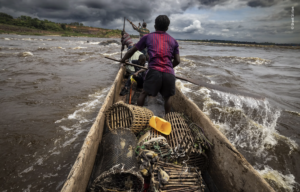
Deadly cargo, Brent Stirton
Hunters return from an island upstream of Brazzaville with a cargo of fruit bats – a bushmeat now popular throughout much of West and Central Africa. Up to 150 are caught each day during peak hunting season, threatening bat populations. Fruit bats are carriers of the highly transmissible Ebola virus, creating a risk for those handling and buying bushmeat. However, with a single bat fetching between $2-4, for those living on less than $2 a day, selling fruit bats provides a vital income and is worth the risk.
Now some hopeful ones!
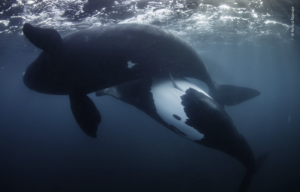
New life for the tohorā, Richard Robinson
Known by the Māori as tohorā, the New Zealand population of southern right whales was hunted to near extinction in the 1800s, so now every new calf offers new hope.

Smooth mover, Tan Yong Lin
Despite disappearing from Singapore in the 1960s due to pollution and the intense development of rivers and coastal areas, the country’s population of smooth-coated otters has bounced back thanks to a concerted effort to clean up the waterways.
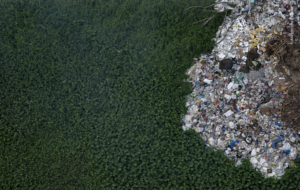
The picture that cleared the rubbish, Adityakrishna S Menon
Once fringed with mangroves, this part of the estuary is now overrun with taro, a tropical plant that typically grows in swamps. The spread of taro is symptomatic of pollution in the estuary. Taro thrives on the nutrients in the dumped waste, outcompeting the mangroves. After seeing Adityakrishna’s shocking image, a local journalist decided to produce a documentary highlighting the issue. Following the piece the site was cleaned up and dumping waste in this area is now prohibited.
There are unfortunately more depressing ones than hopeful ones. I personally shed a few tears during the exhibit. I felt powerless. Upon seeing the first few photographs I was like “yeah, that’s really bad, but we can fix it”. But then came along another issue, and then another problem. Overfishing, water pollution, all implications of the climate crisis, land destruction, environmental injustice, overconsumption and waste, illegal hunting… To me, the size of the problem seems massive and impossible to tackle. But the good thing is that no single individual is supposed nor expected to tackle it all by themselves. I am fortunate enough that I get to contribute to the solutions as part of my work. I am part of an amazing community that pushes ETH always further on the sustainability path. Feeling like I’m part of the solution and belonging to such a community really help me with my eco-anxiety. And that’s all I wish on anyone concerned with the climate crisis.
Here at SSC we were inspired by this exhibit, and have decided to organize our very own at ETH. We’re happy to launch a “Wildlife crisis photography” contest! Over the summer, send us your best wildlife photographs with an accompanying small paragraph, making sure to connect the dots between the animal you’re shooting, and the climate crisis or impact of human actions. The best shots will be exhibited at ETH.
This piece was written for and published in the May 2023 edition of the Polykum magazine.
Toni Morrison’s quote, “It’s not possible to constantly hold onto crisis. You have to have the love, you have to have the magic”, speaks volumes to my climate-crisis-concerned soul.
My relationship with environmental activism didn’t start with a sudden realisation, or what other activists might call a “catalyst moment”. Rather, I remember the moment I realised climate activism was going to be an important part of my life like this: I was sitting in class, scrolling on Instagram – as one does – seeing posts and stories about the climate strikes happening nearby. And I just thought “Why am I here and not in the streets?”
My journey at the Student Sustainability Committee
So when I got to ETH three years ago, I didn’t hesitate for a second to join the Student Sustainability Committee (SSC). And since then, I haven’t left that community.
I started as a helping member: distributing flyers, putting up posters, supporting others at events. I gradually took on more and more responsibilities, organising events of my own, then becoming coordinator of the Events team. I was even president for a year. Now, I take care of our interactions with other entities and organisations. My duties in the committee evolved alongside my beliefs. When I started, I was all about raising awareness and educating others about the climate crisis. Now, I prefer to focus my energy on creating synergies and partnerships with other organisations that do work that’s similar and complementary to ours. There’s a place for everyone.
A sense of community
But that’s just the surface of SSC. Throughout the years, people have come and gone, but the feeling of community has stayed and strengthened. Via the committee I’ve met some of my closest friends – stressing about budget deadlines and events organisation will do that to you. Most importantly, it’s given me the space to process, experience, and share my feelings about the climate crisis. Your fellow SSC members know about the mess we’re in. Although we don’t all agree on anything – as a rather heterogeneous organisation, we’ve got your typical tree-hugger, radical protester, tech lover, etc. – we do share a common belief: that we have to do something.
So forget about dinners where you feel like the outsider, pestering your friend for flying to Croatia for four days, or for eating that piece of meat. No more conversations where you have to justify yourself for not wanting to fly and for shopping second-hand, or having to explain to your uncle that no, overpopulation is not the cause of climate change. Rather, you can discuss how the latest IPCC report made you feel (angry? defeated? super motivated? – all valid emotions), about the expected impact of the upcoming referendum, or that biodiversity loss is depressing AF. Feeling like you belong and being surrounded by like-minded people is not a negligible thing, on the contrary. Eco-feelings (an individual’s emotional responses to environmental issues or concerns) are real, and especially affect young people. Eco-anxiety, eco-grief, eco-anger are all valid feelings that do not need to be fixed (they’re a healthy response to the absurd mess we’re in) but they can be alleviated through the benefits of peer interactions.
Join the crew!
Additionally, being part of such an organisation allows you to channel whatever you might be feeling towards the climate crisis into action. Feeling like no one cares, even though they should? Organise a panel discussion on *insert your current climate-related obsession*! Do you want to discuss ETH’s net zero strategy with its administration? Join our team reviewing it! Interested in including more sustainability-oriented content in your curriculum? Our education team is always looking for help!
You probably got the idea by now. Being a strong and driven community has allowed us to build a strong network of contacts, and to establish meaningful relationships with decision-making ETH bodies. Leveraging that, our members establish and participate in impactful projects, with the ultimate goal of making ETH more sustainable as an institution.
I can’t help but live the crisis, but it’s a heck of a lot easier to do it while surrounded by such a magical community.
Interested in learning more about our work and organisation? Reach out 🙂
This piece was written for and published in the March 2022 edition of the Blitz magazine.
I was scrolling on my phone, as usual during my afternoon coffee break, when a Guardian notification popped on my screen: «Antarctic areas reach 40C above normal at same time as north pole regions hit 30C above usual levels». Great, I thought, for a change. I didn’t even bother to read it, as I already knew what it would contain: climate breakdown even sooner than anticipated, tipping points, etc. Sadly, not a day passes without such alarming and disheartening news: «Great Barrier Reef authority confirms unprecedented sixth mass coral bleaching event», «Kenya’s quiet slide underwater», «Climate crisis puts Australia’s food supply at increasing risk», etc. Different people develop different ways to deal with this constant flow of daunting information: few deny the science, many do not really care or grasp the urgency, others believe in not-yet-developed technologies, some get angry, others get depressed. I tend to fluctuate between the last two options, with a transitional state of «it is what it is» (my current mood). Having essentially ignored the latest piece of news, I did not immediately make the connection when the head of my lab asked what were my plans for the next couple of months and, upon my answering, immediately dispatched me to the Arctic. So here I was, freezing my ass off on an expedition boat probably older than my grandmother, on my way to a «strictly confidential» scientific mission. «You’ll be briefed there», my advisor had told me. After what seemed like an infinite loop of eating, vomiting (I was never fond of boat rides), and napping, we finally set foot on solid ground. And, oh boy, how I wished our boat had sunk at sea, for I was not in the least prepared for what I was about to witness. At first glance, nothing seemed out of the ordinary: containers, tents, measuring equipment… But from a distance I could see that an unusually large crowd was gathered in a circle, wearing protective suits and masks. Noticing our arrival, a CDC personnel offered us the same outfit, and told us to put it on before we could come any closer. I was then briefed: the recent thawing of a large quantity of ice resulted in the defrost of an unknown ancient virus. As an epidemiologist, I was to assess the extent of the threat. Shivering (but not from the cold), I made my way to the crowd. The rest is history.
DISLAIMER: This piece being climate fiction, readers are advised to take it with a grain of salt: it is a very cliché take on a low-probability-high-risk event that may be caused by climate change. But now that I have your attention, I encourage you to take a look at the latest IPCC report, where – among other dreadful impacts of climate change – already-felt consequences of thawing and its future risks are explained: «Glaciers are melting at unprecedented rates, causing negative societal impacts among communities that depend on cryospheric water resources» (TS.B.4.3); «More frequent and intense flood events and increased melting of snow and ice will increase food contamination» (TS.C.3.6). On a final note, I leave you with this quote from We Are The Weather (a book by Jonathan Safran Foer) : «We cannot save the coral reefs. We cannot save the Amazon. It’s unlikely that we’ll be able to save coastal cities. The scale of inevitable loss is almost enough to make any further struggle feel futile. But only almost. Millions of people – perhaps tens or hundreds of millions – will die because of climate change, and the number matters. Hundreds of millions of people, perhaps billions, will become climate refugees. The number of refugees matters. It matters how many days per year children will be able to play outside, how much food and water there will be, how many years average life expectancies will shed. These numbers matter, because they are not just numbers – each corresponds to an individual. […] The biggest challenge is to save as much as we can: as many trees, as many icebergs, as many degrees, as many species, as many lives – soon, speedily, and without delay.»
This piece was written for and published in the December edition of the Visionen magazine.
The year is 2021. The US climate envoy, John Kerry, has said 50% of the carbon reductions needed to get to net-zero will come from technologies that have not yet been invented, and said people “don’t have to give up a quality of life” in order to cut emissions.
The year is 2071. After founding his Texas Institute of Technology and Science (TITS) where students can learn to troll US politicians and manipulate the stock market on Twitter, Elon Musk indefinitely settled on Mars. The red planet is now surrounded by hundreds of tiny space colonies owned by Jeff Bezos, a bit sour of not having reached it first. While Mark Zuckerberg uploaded his consciousness to the Metaverse — hereby decreasing his carbon footprint by a factor of 1000 — Facebook continued to manipulate election results all over the world, resulting in the collapse of the European Union. Using AI surveillance technologies and elaborate AI facial recognition models, authorities worldwide were able to target and arrest climate activists, whose impact was getting too threatening for governments and big businesses. Instead, AIpowered personal assistants were developed and deployed in virtually every household for an accurate estimation of individuals’ carbon footprints, further shifting the focus away from systemic inaction. A social credit system was put in place: buying a BeyondMeat steak would grant you +10pts, buying a locally sourced steak would grant you +6pts, while buying an imported steak would make you lose 5pts. With sufficiently many points, you could watch an hour of Disney+. All the while, the rich and powerful enjoyed virtual reality technologies to continue skiing (when the snow disappeared from the surface of Earth) and going on safaris (after the last cheetahs and rhinos went extinct). There was a debate around geoengineering, but the Netflix hit “SnowPiercer” convinced even its most extreme advocates not to pursue it. Politicians and investors remained hopeful for efficient carbon capture technologies for a few decades, but they were never able to scale up. Most of the trees planted after COP36 went up in flames (releasing whatever CO2 they had managed to absorb in the meantime) during the 2048 global heatwave — featuring the highest temperatures ever recorded at that time, now surpassed every couple of years. And while that would have not been possible had countries chosen to phase out of fossil fuels, phasing down instead allowed Big Oil companies — leveraging AI technologies — to dig up to the very last drop of oil that the Earth holded in.
Thankfully, the year is still 2021, and it’s time to realize that technology is not a silver bullet against climate change. Various technologies bring various insights to the problem: AI [1] can help monitoring coal plant emissions with satellite imagery, Facebook has developed a flood forecasting system designed to provide an early warning to marginalized people in remote areas of Bangladesh, blockchain smart contracts and AI [2] are being used to help the efforts of conservationists. But, quoting Greta Thunberg at COP26, “we don’t have a technology solution that will get anywhere even close [to achieving emissions goals]”. We need courageous policies, we need technological safeguarding, we need activists, we need to phase out fossil fuels, we need to protect and restore nature, we need to protect Indigenous Peoples’ human rights.
The pervasiveness of climate change is what makes it so challenging, but also what makes fighting it stimulating: whatever your field of interest is, you can contribute. At the Student Sustainability Committee, we come from all over ETH, united by a will to bring meaningful change. If any of the above resonated with you, please reach out, we’ll be happy to point you to initiatives that align with your interests.
Contact
- info@ssc.ethz.ch for general inquiries
- events@ssc.ethz.ch to reach our Events team
- development@ssc.ethz.ch to reach our University Development team
- communication@ssc.ethz.ch to reach our Communication team
- outreach@ssc.ethz.ch to reach our Outreach team


